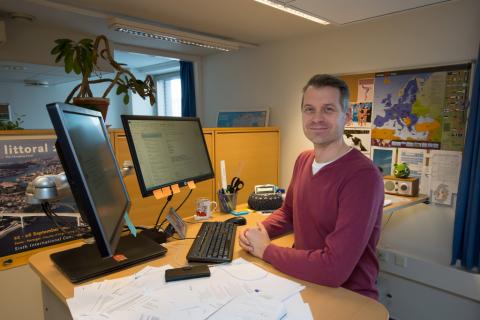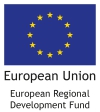Application submitted – now what?
Monday, March 6, 2017 - 10:12
The third and last full-fledged call of the Central Baltic programme closed on 27 February 2017. In this interview Samu Numminen, team leader of our project team explains what happens to an application, after it has been submitted.
Who is Samu Numminen?
I am a geographer by education and I have been working in and with projects in the environmental sector for my whole career. Working at the Central Baltic programme has been a good way to gain new experience and to work with projects from the other side of the fence.
What is your area of expertise?
Environmental issues in general, coastal and maritime in particular.
What is your role in the project team?
I am responsible for priority 2 (Sustainable use of common resources) and I am also the team leader. I mostly deal with tourism, coastal and maritime management, urban planning and projects that aim at improving the state of the water in the Baltic Sea.
What happens to an application after it gets submitted?
It comes to us, the project team. After the call closes we start to evaluate the applications. The first step is the technical check: if the mandatory information in the application is filled in, we move forward with the assessment. Small projects will be fully assessed, whilst regular projects undergo the first step of the assessment at this point.
When the assessment is completed, we bring the applications to the Steering Committee. The Steering Committee consists of representatives from all of the programme area’s countries. Decisions about small project applications will be taken during this step: small projects will get the final approval or rejection. In regard to regular projects, it will be decided which ones will get approval for continuing to the second step. During the second step, regular project applicants will fill in the application form fully; the information to write in the 2nd step of the application includes a detailed budget and a work plan. It takes almost a full year for the whole application process to be completed.
What kind of services did you provide to the applicants when the call was open?
Even before the call opened we started giving consultations for potential project ideas. We have had consultation days in each programme country and two Project Applicant Seminars. We also answer consultation requests via email, phone, Skype and give the possibility to the applicants to meet us face-to-face in separate meetings.
How are tasks distributed within the project team in relation to the project application assessment?
There are seven members in the Project Team: four project managers and three project coordinators. The applications are evenly distributed for evaluation to each member of the project team.
How are applications assessed?
As mentioned earlier, we start with a technical check. After evaluating which applications are technically eligible we move on to content assessment. Every project application is first assessed separately by two members of the project team. They both write their individual evaluations and recommendations and then they discuss the application together until they find a common understanding. The whole process is described also in the Programme Manual.
How many applications have been submitted in the eMS for the third call?
Over 90 applications were submitted for the third call. Regular projects make up for 73% of the applications, while 28% of the applications regarded small projects. In total 93 millions in ERDF were applied for.
The Project team at the Joint Secretariat of the Central Baltic programme works with projects in many ways. Team members consult potential applicants on their initial project ideas and support project preparation. The team also assesses submitted applications as well as supports and monitors the implementation of approved projects. The Project team has a key role in developing guidance for project planning, applying for funding and project implementation.
Elisa Bertieri
Who is Samu Numminen?
I am a geographer by education and I have been working in and with projects in the environmental sector for my whole career. Working at the Central Baltic programme has been a good way to gain new experience and to work with projects from the other side of the fence.
What is your area of expertise?
Environmental issues in general, coastal and maritime in particular.
What is your role in the project team?
I am responsible for priority 2 (Sustainable use of common resources) and I am also the team leader. I mostly deal with tourism, coastal and maritime management, urban planning and projects that aim at improving the state of the water in the Baltic Sea.
What happens to an application after it gets submitted?
It comes to us, the project team. After the call closes we start to evaluate the applications. The first step is the technical check: if the mandatory information in the application is filled in, we move forward with the assessment. Small projects will be fully assessed, whilst regular projects undergo the first step of the assessment at this point.
When the assessment is completed, we bring the applications to the Steering Committee. The Steering Committee consists of representatives from all of the programme area’s countries. Decisions about small project applications will be taken during this step: small projects will get the final approval or rejection. In regard to regular projects, it will be decided which ones will get approval for continuing to the second step. During the second step, regular project applicants will fill in the application form fully; the information to write in the 2nd step of the application includes a detailed budget and a work plan. It takes almost a full year for the whole application process to be completed.
What kind of services did you provide to the applicants when the call was open?
Even before the call opened we started giving consultations for potential project ideas. We have had consultation days in each programme country and two Project Applicant Seminars. We also answer consultation requests via email, phone, Skype and give the possibility to the applicants to meet us face-to-face in separate meetings.
How are tasks distributed within the project team in relation to the project application assessment?
There are seven members in the Project Team: four project managers and three project coordinators. The applications are evenly distributed for evaluation to each member of the project team.
How are applications assessed?
As mentioned earlier, we start with a technical check. After evaluating which applications are technically eligible we move on to content assessment. Every project application is first assessed separately by two members of the project team. They both write their individual evaluations and recommendations and then they discuss the application together until they find a common understanding. The whole process is described also in the Programme Manual.
How many applications have been submitted in the eMS for the third call?
Over 90 applications were submitted for the third call. Regular projects make up for 73% of the applications, while 28% of the applications regarded small projects. In total 93 millions in ERDF were applied for.
The Project team at the Joint Secretariat of the Central Baltic programme works with projects in many ways. Team members consult potential applicants on their initial project ideas and support project preparation. The team also assesses submitted applications as well as supports and monitors the implementation of approved projects. The Project team has a key role in developing guidance for project planning, applying for funding and project implementation.
Elisa Bertieri



